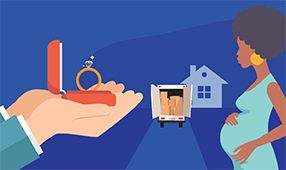Many potential home buyers are reluctant to even consider a move as the COVID pandemic continues to affect the economy. But the low inventory of housing available for purchase is supporting prices while record low mortgage rates are encouraging buyers to take the plunge. Housing inventory dropped nearly 30% in the first half of 2020, meaning buyers often had to bid above asking price or get involved in a bidding war.
For those looking to trade up or enter the housing market for the first time, now could be the time to strike. Finding the right house in a neighborhood you like is still the paramount consideration, but financial considerations are also a big part of the equation, especially now with the economic uncertainty.
How do you know if you’re ready to take the plunge? To start, here are three important questions you’ll need to answer before getting serious about buying a home.
1. Do you understand your credit history?
Unemployment has reached a postwar record high. As millions apply for unemployment insurance due to being laid off or furloughed, experts are urging people to keep their priorities straight and spend the money necessary for necessities and worry about your credit rating later. This is undoubtedly good advice, but those seeking a mortgage need to pay attention to their credit nonetheless.
Your credit score is important, but lenders will be looking at your entire credit history when considering you for a loan. Pre-pandemic spending patterns are important in this regard. How you stack up determines not just whether you will get a loan, but how much it will ultimately cost you.
The good news: Even borrowers with less-than-sterling credit can qualify for low rates in this environment. Immediately after the mortgage crisis of 2008, even some borrowers with good credit scores in the 700s had trouble getting loans. Currently, however, the minimum score for applying for a conventional mortgage—one that will be backed by the federal agencies Fannie Mae and Freddie Mac—is about 620, depending on the lender.
But if your score tracks lower than that, don’t despair. The minimum score for Federal Housing Administration (FHA) loans can be as low as 500 in some cases. And there are ways to massage your credit score before embarking on your housing search.
It’s important to note that Fair Isaac Corporation, which calculates FICO scores, has tweaked its methodology starting in 2020. It is using the massive data it collects to take a more nuanced view of a consumer’s payment history. This will improve the scores of those who follow good credit management practices but lower scores for those who use techniques like consolidating credit-card debt and then running up new balances.
The new scores will also review the past two years of your history, instead of relying on just the month you apply for credit. This can be helpful for those who historically have managed well but are temporarily distressed by the COVID impact. However, this will not immediately affect those applying for mortgages, as Fannie Mae and Freddie Mac, which acquire most conventional loans, still want to use the older version of FICO scores. It’s not certain how quickly others, such as credit card companies, will adopt the new score.
Beyond just the score, potential lenders will be looking at your debt-to-income ratio—that is, what percentage of your pretax gross monthly income goes to paying existing debt—as well as your employment history. They are looking to see if you can make the monthly mortgage payments and are likely to continue to do so over the 15-30-year life of the loan. A desirable debt-to-income ratio, including the new mortgage payment, is about 36%. The housing-to-income ratio itself should be about 28%. Note that these are just guidelines and are not carved in stone.
2. Do you know how much you can really spend?
The 2008 housing crisis put an end—at least temporarily—to banks lending to subprime borrowers or luring people in with teaser rates giving them a false sense of how much they could borrow. Some of these lax practices began to creep back into the market before COVID-19 struck, but the pandemic has made lenders cautious once again as they hurriedly provision for a wave of defaults due to bankruptcies. The one maxim that remains valid is that ultimately it is you who must take the responsibility for a loan.
The debt-to-income ratio is a useful guideline, but, there are many other monthly expenses to take into account—groceries, childcare, clothing, transportation, internet-cable, travel, entertainment and others. If you don’t already budget your monthly expenses, it would be useful to do a reality check on where your monthly income goes. On the other hand, the deduction for mortgage interest will reduce your tax bill, allowing you in some cases to reduce your withholding and increase your take-home pay. However, you have to itemize your deductions to get that benefit and the 2017 tax reform doubles the standard deduction to the point that many taxpayers will no longer itemize.
Besides the actual price of the home—which may be above or below the listing price, depending on the local real estate market—there are several other considerations in computing the monthly cost.
Among the variables to consider are a 15-year versus a 30-year mortgage. The shorter term will mean higher monthly payments, but you will pay off the loan more quickly, build up equity much faster and pay far less in interest over the life of the loan. Then there is the question of a fixed-rate mortgage over adjustable rate. The adjustable rate will be lower at the beginning because it is less risk for the lender, but it could go higher, even much higher, as the loan rate is adjusted to market conditions over its life. Most borrowers have taken advantage of the historically low rates in recent years to opt for fixed rate to lock in a good rate for the life of the loan.
How much money you can put down can also affect the amount of the mortgage and the monthly payment. If you can put down the ideal 20%, then you can also save the cost of mortgage insurance, which the lender will require when the down payment falls below that threshold. In any case, it is difficult to get a conventional mortgage with less than 10% down. FHA loans, which are insured by the federal government, require only 3.5% down. Loans through the Veterans Administration sometimes require no money down at all.
The rate you get will depend on your credit score, your credit and employment history, any other assets you may have and other financial considerations. If you don’t get the best rate, you can still lower it by purchasing “points”—upfront money to lower your interest expense. Points are 1% of the purchase price and you can purchase up to four points. Unlike the down payment, the points are tax-deductible because these represent prepaid interest. Whether you go this route or not depends on how much money you can put down at closing and how long you plan to be in the house. It can take several years to recoup the saved interest from buying points, so it is probably not a good option if you think you will be moving in a few years.
The 2017 tax reform lowered the size of a loan eligible for the mortgage tax deduction to $750,000 from $1 million for loans granted from 2018 on. It also eliminated the separate deduction for a home equity loans, rolling it into the home acquisition debt.
It’s important to keep in mind that property taxes and homeowners’ insurance will also be part of your monthly payment, feeding into an escrow account to make the payments for these when they fall due.
Finally, the dreaded closing costs. The buyer can expect to pay from 3% to 5% of home’s price in closing costs. These include such things as attorney fees, title transfer, mortgage fees, points, prepayments for the initial mortgage and escrow charges, and other fees and charges. Lenders are required to provide a “good faith estimate” of these charges when you apply for a loan so there are no nasty surprises. Buyers are largely spared the commissions for the real estate brokers—even the buyer’s broker—since these are usually paid by the seller.
3. Can you cover the “extra” expenses?
The 1986 comedy “The Money Pit” still pops up on cable because the nightmare vision of what can happen to new, unsuspecting homeowners is still very relevant. Your home inspection might tell you the roof is OK, but not necessarily that it will need repair within a year. Or the HVAC. Or any of the multitude of things that keep a home functioning and comfortable. Older houses—especially those described as “fixer-uppers”—may need substantial renovation to meet your expectations. In short, you want to be careful not to totally deplete your resources in buying the house because you may be facing significant maintenance costs sooner than you think. Some loans will provide extra funds for renovation, or a separate home equity line of credit may be available.
There are many costs associated with moving into a house beyond the purchase price and closing costs. There are the moving costs themselves, but also the costs for additional furniture and furnishings. Bathrooms, kitchens, plumbing or electricity may require updating or upgrading. Outside the house, too, there may be urgent landscaping issues or repairs needed for fences, sidewalks, driveways and more.
There are various rules of thumb for how much home maintenance might cost. One is 1% of the purchase price per year on average. Another is $1 per square foot a year on average. But these are just rules of thumb and actual costs could diverge substantially depending on the age of the home and previous maintenance.












